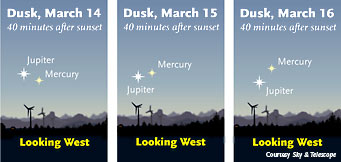Most people have never knowingly seen Mercury, the innermost planet — so if you spot it, you're joining an elite club. And the best news is that the price of admission is nil. Mercury is actually extremely easy to see, as long as you know exactly when and where to look.

Mercury passes Jupiter in bright twilight around March 15th. After that, Jupiter appears lower each evening, while Mercury continues its climb away from the setting Sun until March 22nd.
Sky & Telescope diagram
If you live in the Northern Hemisphere and prefer to go out in the evening rather than before sunrise, then this March is your best chance to spot Mercury all year, for two reasons. It's Mercury's highest and longest evening apparition. In addition, Mercury happens to spend the week from Saturday, March 12th, to Friday, March 18th, within 5° of Jupiter. (That's half the width of your fist at arm's length.) And while you might be able to overlook Mercury alone, the pairing is absolutely unmistakable.
All you need is a clear evening and a viewing site with an good view down to the west horizon. The shore of a big lake (or ocean) would work well, as would the top of a tall building or hill. Note the spot where the Sun sets, and then start scanning above (and slightly to the left) of there for Jupiter. Jupiter may be visible immediately if the air is very clear, but it will be more obvious 15 or 30 minutes later when the sky is darker (though Jupiter will also be lower).
Once you've found Jupiter, look for Mercury near it using the diagrams here. These are by far the brightest objects in that part of the sky, so there's no chance of mistake. The only possible confusion would be incoming airplanes, which often hold a similarly tight configuration if you live near an airport. But airplanes will shift within a minute or two, while Jupiter and Mercury stay put except for their gradual descent toward the horizon.
Mercury appears higher each evening in March until the 22nd, while Jupiter appears ever lower. So by the end of that period, Mercury may actually be the more obvious of the pair, despite the fact that it's slowly fading. Starting around March 25th, Mercury plunges back toward the Sun, fades rapidly, and soon becomes hard to locate with the unaided eye.
In a telescope, however, the later part of this apparition is most interesting, because that's when Mercury grows into a long, thin, crescent. It's 7
 4
4









Comments
Joe Stieber
March 11, 2011 at 12:54 pm
I spotted Mecury this past Tuesday evening, 08-March-2011, about 20 minutes after sunset. It wasn't very high, about 5.5 degrees and descending, but I had a low horizon at the local baseball field complex here in the New Jersey suburbs (near Philadelphia). I used binoculars to find it, and then I could glimpse it off-and-on naked eye (despite some haze and patchy clouds along the western horizon). This is my first sighting of Mercury for this elongation and I'm looking forward to seeing it a few more times in the next couple of weeks. Since I already saw it during January's morning elongation, I'm going to try and spot Mercury at each of of the remaining five elongations this year (I've seen Mercury a number of times in the past, but never at each of its elongations during a calendar year).
You must be logged in to post a comment.
manmeet
March 14, 2011 at 9:26 am
I spotted the Mercury today !!
Was prety easy to spot after locating the Jupiter with mine 12x50 binocluars. But both Jupiter and Mercury were visible easily with naked eyes. I was able to find the planets 20 minutes after the sunset. Mercury was so easily visible that I thought it cant be Mercury and thought it would be a star. But it was Mercury indeed. Photographed both of them with Sony DSC-H2, and had nice snaps.
Nice...thanks to skyandtelescope for intimating this paring up..!!
You must be logged in to post a comment.
Gayle
March 15, 2011 at 9:09 pm
Super view here 2 hrs north of Los Angeles at 7:45pm. I have a good clear view to the west and wispy clouds finally moved. Could hardly believe Mercury would look so big ... what a kick!
Thanks for the good diagram..
You must be logged in to post a comment.
David Fried
March 19, 2011 at 10:36 pm
Saw Mercury tonight as an easy naked-eye object from the highest point within the city limits of Boston (Peter's Hill, Arnold Arboretum). Having only glanced at the finder chart I was sure that Jupiter was above Mercury, rather than below, so I took it for granted that I was looking at Jupiter. Strangely, it didn't look anything like Jupiter in my 10 x 50s--no moons, for one.
Only when I got home did I realize that it was in fact Mercury. I was astonished at how bright it was.
BTW, the top of the Hill was crowded with people out to see the Supermoon. Two or three, to my surprise, came up to me and said "Can you see Mercury?"
You must be logged in to post a comment.
You must be logged in to post a comment.